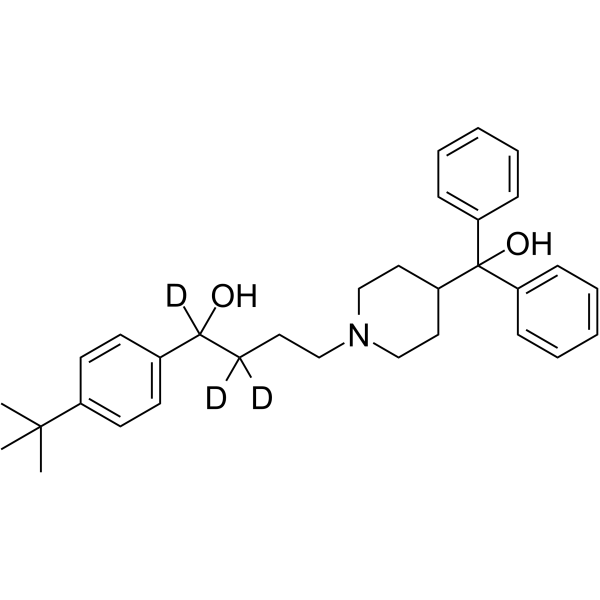Terfenadine-d3
Modify Date: 2025-09-12 14:36:13

Terfenadine-d3 structure
|
Common Name | Terfenadine-d3 | ||
|---|---|---|---|---|
| CAS Number | 192584-82-0 | Molecular Weight | 474.69 | |
| Density | N/A | Boiling Point | N/A | |
| Molecular Formula | C32H38D3NO2 | Melting Point | N/A | |
| MSDS | N/A | Flash Point | N/A | |
Use of Terfenadine-d3Terfenadine-d3 ((±)-Terfenadine-d3) is the deuterium labeled Terfenadine. Terfenadine ((±)-Terfenadine) is a potent open-channel blocker of hERG with an IC50 of 204 nM[1]. Terfenadine, an H1 histamine receptor antagonist, acts as a potent apoptosis inducer in melanoma cells through modulation of Ca2+ homeostasis. Terfenadine induces ROS-dependent apoptosis, simultaneously activates Caspase-4, -2, -9[2]. |
| Name | Terfenadine-d3 |
|---|
| Description | Terfenadine-d3 ((±)-Terfenadine-d3) is the deuterium labeled Terfenadine. Terfenadine ((±)-Terfenadine) is a potent open-channel blocker of hERG with an IC50 of 204 nM[1]. Terfenadine, an H1 histamine receptor antagonist, acts as a potent apoptosis inducer in melanoma cells through modulation of Ca2+ homeostasis. Terfenadine induces ROS-dependent apoptosis, simultaneously activates Caspase-4, -2, -9[2]. |
|---|---|
| Related Catalog | |
| In Vitro | Stable heavy isotopes of hydrogen, carbon, and other elements have been incorporated into drug molecules, largely as tracers for quantitation during the drug development process. Deuteration has gained attention because of its potential to affect the pharmacokinetic and metabolic profiles of drugs[1]. |
| References |
| Molecular Formula | C32H38D3NO2 |
|---|---|
| Molecular Weight | 474.69 |
| InChIKey | GUGOEEXESWIERI-AKOBIBDASA-N |
| SMILES | CC(C)(C)c1ccc(C(O)CCCN2CCC(C(O)(c3ccccc3)c3ccccc3)CC2)cc1 |